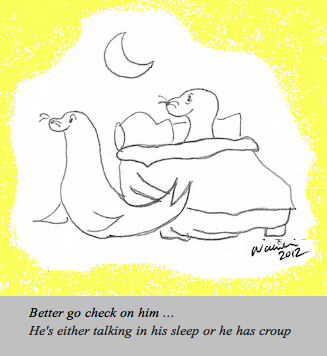 We can tell from this past week at the office that croup season has started. DON’T PANIC! Read on to learn what to look for. Please also listen to our podcast on this same subject. Dr. Lai heard one mom say that she listened to the podcast three times in one night…nights with croup can be very long indeed.
We can tell from this past week at the office that croup season has started. DON’T PANIC! Read on to learn what to look for. Please also listen to our podcast on this same subject. Dr. Lai heard one mom say that she listened to the podcast three times in one night…nights with croup can be very long indeed.
You wake up in the middle of the night to the sound of a seal barking…inside your house. More specifically, from inside a crib or toddler bed. Unless you actually have a pet seal, that sound is likely the sound of your child with croup.
“Croup” is the lay term for any viral illness causing swelling of the voice box (larynx) which produces a seal-like cough. The actual medical term is “laryngotracheobronchitis.” In adults, the same viruses may cause laryngitis and hoarseness, but minimal cough. In children the narrowest part of a child’s airway is his voice box. So not only does the child with croup sound hoarse when he talks and cries, but since he breathes through a much narrower opening, when he forces air out with a cough, he will sound like a barking seal. When a kid with croup breathes in, he may produce a weird guttural noise, called “stridor.”
Many viruses cause croup, including flu (influenza) viruses. Therefore, a flu vaccine can protect against croup. While no antibiotic or other medicine can kill the croup causing viruses, here are some ways to help your child feel better.
What to do when your child has croup:
Stay calm. The noisy breathing and barky cough frighten children and their parents alike. It’s easier for the child to breathe when he is calm rather than anxious and crying. So, even if you are scared, try to act calmly since children take their cues from their parents.
Try steam. Run the shower high and hot, close the bathroom door and sit down on the bathroom rug with your child and sing a song or read a book or just rock him gently. The steam in the bathroom can help shrink the swelling in your child’s voice box and calm his breathing.
Go outside. For some reason, cool air also helps croup. The more misty the better. In fact, many a parent in the middle of the night has herded their barking, noisy breathing child outside and into the cold car (with windows slightly cracked open) to drive to the hospital. Once in the emergency room, the parents are surprised to find a happily sleeping, or wide awake, chatty child, “cured” by the cold night ride.
Run a humidifier. A cool-mist humidifier running in your child’s room will also help. Make her room feel like a rain forest, or the weather on a really bad hair day, and often the croupy cough will subside. Cool-mist humidifiers in the child’s room are safer than hot air vaporizers because vaporizers pose a burn risk. It’s the mist that helps, not the temperature of the mist.
Offer ibuprofen or acetaminophen. Your child may cough, and then cry, because her throat is sore. Pain relief will make her more comfortable and allow her to get back to sleep.
Who needs further treatment?
Most kids, more than 95%, who come down with croup, get better on their own at home. Typically, croup causes up to three nights of misery punctuated by trips into the cold night air or steam treatments. During the day, kids can seem quite well, with perhaps a slightly hoarse voice as the only reminder of the night’s tribulations. Why croup is worse at night and much better during the daytime hours remains a medical mystery. One theory is, just like ankles swell after one is upright all day, swelling in the voice box increases when people lie down. After the three nights, your child usually just exhibits typical cold symptoms with runny nose, a regular sounding cough, watery eyes, and a possible ear infection at the end. Then brace yourself for next time—kids predisposed to croup tend to get croup the next time a croup causing virus blows into town. But take heart, most kids outgrow the disposition for croup around six years of age.
Some kids do develop severe breathing difficulties. If your child shows any of these symptoms, get emergency medical care:
Turns pale or blue with coughing. Turning red in the face with coughing is not as dangerous.
Seems unable to swallow/unable to stop drooling.
Breathing fails to improve after steam, cool air, humidity, or breathing seems labored– nostrils flare with every breath or chest heaves with every breath—pull up their night shirts to check for this. See this link for an example of labored breathing.
Mental state is altered: your child does not recognize you or becomes inconsolable.
Child is unimmunized and has a high fever and drooling along with his croup symptoms: he may not have croup but rather epiglottitis, most commonly caused by a vaccine-preventable bacteria. This is a different, more severe illness that can be fatal and requires airway management as well as antibiotics in a hospital.
We searched the internet for a good example of what the “seal bark” cough of croup. The best imitation we found is actually the sound of a sea lion. We will have to ask a veterinarian sometime if seals and sea lions get croup. If so, what do they sound like?
Julie Kardos, MD and Naline Lai, MD
©2012, 2015 Two Peds in a Pod®



